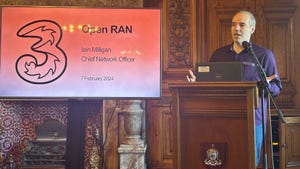Telefónica in edge talks with Amazon Greengrass
Spanish operator reveals it has been in discussions with Amazon about a new project to automate its central offices and give them more processing capabilities.

MADRID -- Zero Touch & Carrier Automation Congress -- Telefónica is in talks with Internet giant Amazon about a potential edge computing service that would take advantage of new processing capabilities at the Spanish operator's central offices.
A partnership could see Amazon.com Inc. (Nasdaq: AMZN) relying on Telefónica's facilities to support its Greengrass edge-computing service, which allows customers to run cloud computing from end-user devices instead of in large data facilities.
Under a program called OnLife, Telefónica is planning an upgrade of its central offices to give them more autonomy and independence from its transport networks and large data centers. The operator is worried that growing usage of new products and services could swamp those facilities in future. It operates about 10,000 central offices at its fixed-line business in Spain, and believes automating them will allow it to provide new types of service, some in partnership with third parties.
"If we allow third-party players to put their solutions at the edge and guarantee latency, the growth is going to be exponential in the services we provide," said Alfonso Carillo Aspiazu, the chief architect of Telefónica's OnLife networks initiative, during today's Zero Touch & Carrier Automation Congress in Madrid.
With their real estate footprint, operators have long been excited by edge computing as a potential growth opportunity. By taking IT resources out of data centers and hosting them at aggregation points closer to end users, telcos would be able to cut latency -- a delay that occurs when signals are sent over data networks -- and provide support for more demanding applications.
Little has happened in this market so far, however, because of the investment and technical challenges that building an edge network could entail. Some operators and industry commentators have also questioned the immediate need for low-latency services.
But OnLife could eventually represent a major step forward for Telefónica. The carrier's ultimate vision is to host an array of third-party products and services at its central offices, allowing customers to choose the ones that best suit their needs.
Part of Telefónica could potentially morph into a "platform-as-a-service" provider, said Aspiazu, when quizzed about the operator's intentions during a presentation earlier today.
How Amazon Greengrass would fit into this picture is not yet clear, but a tie-up might help the Internet giant to address some of the challenges it faces in offering the Greengrass service. "We are working with Amazon on Greengrass and seeing where it is best to fit it," said Aspiazu. "They are trying to get solutions to fit and we are working with them on an experimental basis to see if a solution can fit here."
Want to know more about the emerging SDN market? Check out our dedicated SDN content channel here on Light Reading.
Either with Amazon or with other partners, service offerings based on the OnLife project are unlikely to appear quickly. Aspiazu acknowledged that Telefónica has some way to go before it can deploy the technology on a massive scale. Moreover, it has only just started to look at pushing the technology even closer to the edge, potentially using street cabinets and other local facilities. Without such capabilities, the operator might struggle to satisfy the needs of some partners.
On the technical side, Telefónica has been using open source tools developed by the Open Networking Foundation (ONF) to come up with a new-look design for its central offices. An ONF project known as CORD (which stands for "central office re-architected as a data center") provided the essential blueprint for OnLife, said Aspiazu, although Telefónica has made some tweaks.
The basic premise, though, is to "software-ize" the central office, phasing out any proprietary black boxes and introducing commodity switching and IT infrastructure. Right now, it is using a white box optical line terminal based on the GPON broadband standard, but tests of XGS-PON, a next-generation fiber technology, are underway. Telefónica is also making use of a cloud platform called Open Nebula. "This has all the functionality needed for cloud management systems," said Aspiazu.
A key objective is to get rid of legacy technologies and make the central offices more programmable on a standalone basis. "Once you unplug the connection from legacy equipment you don't need to coexist with anything and that was instrumental in what we have done and are testing in central offices," said Aspiazu. "That allowed us to put third-party services at the central office."
Earlier this week, Juan Carlos Garcia, Telefónica's director of technology and architecture, revealed that Telefonica has removed as many as 400,000 network elements from its Spanish central offices in the last four years. (See Telefónica to Hit Gas on Automation With 5G Rollout.)
Aspiazu is concerned that Telefónica will face "unsustainable traffic growth on its transport network" if it does not shift processing capabilities to its central offices.
OnLife bears comparison with the Access 4.0 project at Deutsche Telekom. Like Telefónica, the German operator is using CORD's blueprints to design an more software-based broadband access network, although it has said its main goal is to reduce costs rather than open up new service opportunities. (See DT Preps CORD Effort to Slash FTTB/H Costs.)
— Iain Morris, News Editor, Light Reading
Read more about:
EuropeAbout the Author(s)
You May Also Like












